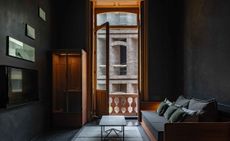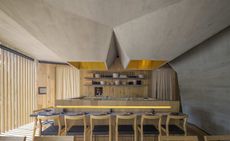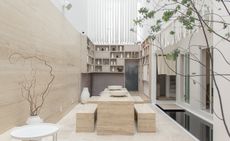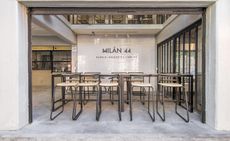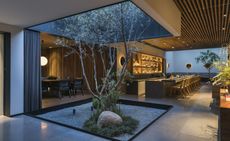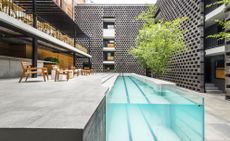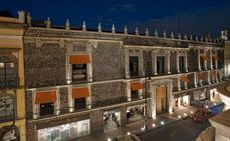From Mario Pani to mezcal: a tour through modern-day Mexico City
Mexico City tour: plan your 2023 escape with a guide to the must-sees from erstwhile locals, Wallpaper* contributors Molly Mandell and James Burke
- (opens in new tab)
- (opens in new tab)
- (opens in new tab)
- Sign up to our newsletter Newsletter
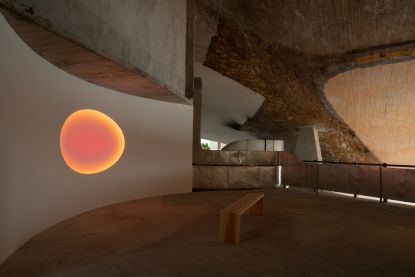
‘Mexico City is a phenomenon in which there is room for all imaginations,’ wrote the novelist Carlos Fuentes. This oldest (1325AD), highest (2,240m) and largest (22 million inhabitants) metropolis in North America is full of contradictions, question marks, and undoubtedly magic. Marfa-based arts and culture writers Molly Mandell and James Burke, who called the Mexican capital home before landing back just north of the border, give a glimpse of its allure with a Mexico City tour that spans from a modernist guest house to a compelling craft showroom, mindful cold plunging to mouthwatering dining.
Mexico City tour: the insider’s must-sees
Casa Pani guest house

An exterior view of Casa Pani in Mexico City
With its thoughtful details, intimate character and design-forward clientele, Casa Pani – the guest house founded by architect Miggi Hood, entrepreneur Marie Cazalaa and mezcal brand owner Yola Jimenez – fills a much-needed gap in the city’s accommodation offerings. Originally designed by the oft-overlooked modernist pioneer Mario Pani, the building has been thoughtfully updated, with its architectural identity intact. A new building at the rear, marked by a circular staircase and attention to natural light, only echoes Pani’s design language. ‘It is close to everything but not slap bang in the cacophony and chaos of Roma and Condesa, nor the shopping district of Polanco,’ Hood says of the location. In the same spirit, the rooms ‘encourage interaction whilst also allowing for privacy’. With only six suites and communal spaces that include living and dining areas, a kitchen, and a dipping pool inspired by sculptor Valentine Schlegel, Casa Pani feels more like someone’s particularly tasteful home. Amenities including a complementary Oaxacan-style breakfast, in-room massages and an art concierge programme elevate the experience. You’re likely to leave the hotel full of creative rejuvenation and better yet, with a fresh set of friends.
casapani.com (opens in new tab)
Martínez restaurant and wine bar

While we typically advocate for exploring Mexican cuisine while in Mexico, Lucho Martínez has a unique way of paying homage to both the country he’s from and those that inform him, justifying the deviation. The menu of his just-opened eponymous restaurant and wine bar takes inspiration from Parisian bistros but uses in-season Mexican ingredients. The drink selection includes vermouths, spritzes and beers, but the assortment of 150 wines steals the show. ‘I wanted a place that showcased my approach to food and hospitality in a more casual way,’ says Mártinez, who is also behind the buzzy but more formal Em and its upstairs 686 bar. However, he is quick to note that the new endeavour goes far beyond an individual philosophy. At its heart, the project is part of a family business – his mentors, Eduardo García and Gabriela López of the acclaimed Máximo, are partners, his wife Fernanda Torres runs operations and their daughter Emilia acts as taste-tester extraordinaire. Interiors came to life in collaboration with Sonora-based ET Studio and Chloé Mason Gray, but the little details – wine glasses and plates emblazoned with a logo designed by Carlo Canún – are what evoke the atmosphere of France’s best in this city across the pond.
@martinez.rest (opens in new tab)
M.A Estudio craft showroom

The brainchild of Melissa Ávila, our former neighbour, this by-appointment showroom offers everything from textiles to ceramics and woven baskets created in collaboration with over 30 artisans, marrying traditional handicrafts with modern sensibilities. A studio visit will leave any buyer with more than a great object but also a meaningful story. Ávila cares deeply for the craftspeople she works with – from Oaxaca, Chiapas, Guerrero, Michoacán and Mexico City. ‘It’s not only about supporting the artisan sector, but also ensuring good practices between designer and artisan and preserving ancestral knowledge and processes,’ she says. She moved into her bright, airy space located in Edificio Humboldt earlier this year. The 1922 art deco building is an artistic refuge of sorts – the magazine Terremoto, fashion designer Carla Fernández and architecture firm O’Brien Van Der Steen, which has been tasked with designing the rooftop extension, can all be found within. M.A Estudio’s playful colours, organic shapes and ingenious ideas bring a certain radiance to the already-cool collection of creatives.
@____m.a____ (opens in new tab)
Ticuchi bar & restaurant

The space at Ticuchi in Mexico City
It’s no secret that Enrique Olvera is a talented chef, but in our opinion, one of his greatest talents lies in sourcing collaborators. Ticuchi, located in the original Pujol space, stands out for its always-exceptional music, small-batch Mexican spirits and mouthwatering menu of shared plates, but above all, for its staff. The bar’s manager Karina Arellano, who hails from Oaxaca, draws on her comprehensive knowledge of mezcales and sotoles to highlight the industry’s most skilled producers. For the full experience, these spirits are best consumed in their purest expressions (with a beer on the side), but skipping one of the bar’s expertly-made cocktails would also be a miss. Try both – alongside dishes like mole negro with squash and a succulent octopus taco – and make an evening out of it, preferably on a Wednesday. The bar-restaurant hits its stride mid-week when DJs like Bógar Adame Mendoza spin norteño classics or Ritmonzón plays cumbia, getting everyone out of their hump-day funk.
ticuchi.mx (opens in new tab)
El Club del Hielo cold plunges

The Wim Hof ice bath method in action, at El Club Del Hielo in Mexico City
Winter swimming, a practice with deep roots in Eastern European and Nordic countries, can be exhilarating, but also meditative and revitalizing. In Mexico, where the water is always warm, Begoña García, a certified Wim Hof method instructor, organises classes and cold plunges in unsuspecting locations. In the city, they take place at early 20th-century gems like Casa Versalles and Edificio Vizcaya, as well as modern outposts including Grupo Habita’s Hotel Condesa. García occasionally takes her work on the road, offering retreats elsewhere, like the new Hotel Terrestre in Puerto Escondido. ‘Cold exposure and breathwork changed my life,’ García muses. ‘From my health to my wellbeing, my thoughts, goals and relationships with others but namely, with myself.’ Instructors and participants all wear black, to encourage a sense of community. Enrol in a workshop on Instagram, join the club for weekly access to plunge and sauna sessions and per their motto, seek discomfort. ‘Anyone, regardless of their age, gender or physical condition, can become a member,’ García insists. ‘All you have to do is come with an open heart.’
Lago / Algo, restaurant / gallery

The bar at Lago / Algo
On the banks of a man-made lake in Bosque de Chapultepec – the sprawling 1,600-acre park in the middle of the city – is a new, free-access cultural space. Flanked by triangular walls of towering windows, the concept has taken up residence in the brutalist paraboloid dreamed up in 1964 by Leónides Guadarrama and Alfonso Ramirez Ponce. Recently, the design firm Naso stripped the interiors to their core, shedding light on the raw concrete and patina of the original structure while also paying tribute to its different expressions over the years. Lago, a farm-to-table restaurant helmed by Micaela Miguel, makes up one half of the project. The chef lives part-time in the verdant Valle de Bravo, two hours south of the city, where her partner Lalo Perez Varona manages Reserva Peñitas – leafy greens, duck and lamb from the farm will feature on the menu that she’s launching in February for Zona Maco. ‘It’s customary to think of an idea and then look for the ingredients,’ she says. ‘Here, the dishes are inspired by the ingredients – their producers and seasons – themselves.’ Algo, which constitutes the other half, offers rotating programming spearheaded by prominent modern art gallery OMR. Like its restaurant counterpart, the space is envisioned as one of constant transformation, guided by artists, visitors and the surrounding nature.
lago.com.mx (opens in new tab)
Mercado Jamaica

At a flower stall, at Mercado Jamaica in Mexico City
Mexico City’s culinary scene – from fine-dining restaurants to cantinas and taco stands – may be as expansive as the city itself, but shopping for a night in constitutes an experience on its own. In addition to stalls that sell produce, meat, medicinal herbs, candles and piñatas, Mercado Jamaica is home to over 1,000 vendors who specialize in more than 5,000 varieties of plants and flowers. This place is a dinner party planner’s dream. Baker and Mexico-City native Odette Alpuche frequents Mercado Jamaica, a one-stop-shop for the fruits, vegetables and floral touches that she puts to use at her café Elly y Gatsby. ‘I love it for many reasons,’ she says, ‘the most logical being the prices, but for me, it’s really the whole experience – the colours, the smells of the flowers and plants, the quality.’ Her tip? Grab a bite while you peruse. ‘I never miss the quesadillas, especially the ones with flor de calabaza, which are my favourite in the city!’
Guillermo Prieto 45, Jamaica, Venustiano Carranza, 15800 Mexico City, Mexico
Escorpio wine shop

Escorpio store in Mexico City
Mexico possesses a rich cultural heritage, predicated on a sense of place and artisanal processes, so it is perhaps no surprise that a young, creative Mexico City crowd increasingly champions wines celebrating small producers, local grapes and traditional styles. Escorpio, run by importer Alonso Maldonado and restaurateur Jake Lindeman, is the city’s first dedicated low-intervention wine shop. Located in Colonia Juárez, the establishment, which features visionary vintners from Mexico – like Aldo Quesada and Silvana Pijoan – and around the world, proves at once fun and educational. While groovy tunes play in the background, Maldonado, Lindeman and their small staff share their expertise with anyone who is willing to learn and listen (their Thursday tastings are the highlight of the week). The space features custom-made tiles, furniture from local design studio La Metropolitana and occasional window signage by artist Ricardo Gonzalez of It’s A Living. More importantly, however, is its casual and relaxed environment, which according to Maldonado, aims ‘to create and reinforce our city’s natural wine community’.
@escorpiocdmx (opens in new tab)
Molly Mandell and James Burke are arts and culture writers and photographers based in Marfa, Texas. Together, they authored the 2018 book Made in Cuba and have contributed to the likes of The Los Angeles Times and Vogue Mexico as well as Wallpaper*. Outside of editorial work, the duo are developing a multi-disciplinary residency programme that provides a dedicated space to explore US-Mexico border culture and the Chihuahuan desert through the lens of art,architecture, food, science and design.
-
 The best blankets for wrapping up this winter
The best blankets for wrapping up this winterWe select the best blankets and throws for hibernating in a cold snap and staying warm all winter long
By Jack Moss • Published
-
 What Daisy did next: how Apple’s evolving team of de-manufacturing machines battles e-waste
What Daisy did next: how Apple’s evolving team of de-manufacturing machines battles e-wasteApple hopes that e-waste will become a thing of the past thanks to its Daisy family of specialist break-down robots that will transform old iPhones into raw materials
By Nick Compton • Published
-
 Brown & Brown designs Cairngorms house blending raw minimalism and nature
Brown & Brown designs Cairngorms house blending raw minimalism and natureSpyon Cop by Brown & Brown is a contemporary home in Scotland’s Cairngorms National Park
By Ellie Stathaki • Published
-
 Umbral — Mexico City, Mexico
Umbral — Mexico City, MexicoBy Daven Wu • Last updated
-
 Oku Mexico — Mexico City, Mexico
Oku Mexico — Mexico City, MexicoBy Melina Keays • Last updated
-
 Ryo Kan — Mexico City, Mexico
Ryo Kan — Mexico City, MexicoBy Mary Holland • Last updated
-
 Milán 44 — Mexico City, Mexico
Milán 44 — Mexico City, MexicoBy Daven Wu • Last updated
-
 Pujol — Mexico City, Mexico
Pujol — Mexico City, MexicoBy Daven Wu • Last updated
-
 Hotel Carlota — Mexico City, Mexico
Hotel Carlota — Mexico City, MexicoBy David Paw • Last updated
-
 Downtown México — Mexico City, Mexico
Downtown México — Mexico City, MexicoBy Sara Henrichs • Last updated



